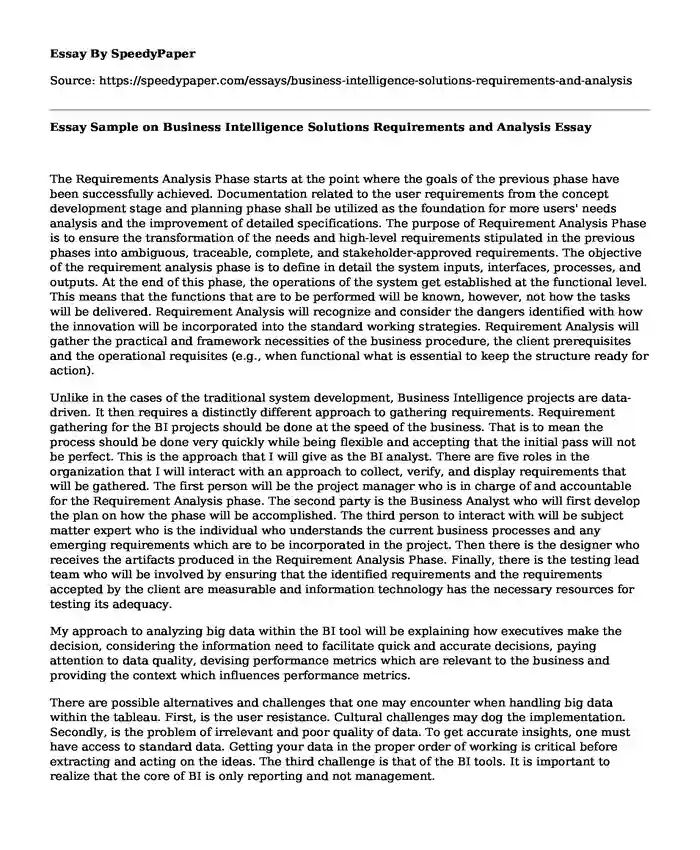
| Type of paper: | Critical thinking |
| Categories: | Business Analysis Intelligence services |
| Pages: | 3 |
| Wordcount: | 603 words |
The Requirements Analysis Phase starts at the point where the goals of the previous phase have been successfully achieved. Documentation related to the user requirements from the concept development stage and planning phase shall be utilized as the foundation for more users' needs analysis and the improvement of detailed specifications. The purpose of Requirement Analysis Phase is to ensure the transformation of the needs and high-level requirements stipulated in the previous phases into ambiguous, traceable, complete, and stakeholder-approved requirements. The objective of the requirement analysis phase is to define in detail the system inputs, interfaces, processes, and outputs. At the end of this phase, the operations of the system get established at the functional level. This means that the functions that are to be performed will be known, however, not how the tasks will be delivered. Requirement Analysis will recognize and consider the dangers identified with how the innovation will be incorporated into the standard working strategies. Requirement Analysis will gather the practical and framework necessities of the business procedure, the client prerequisites and the operational requisites (e.g., when functional what is essential to keep the structure ready for action).
Unlike in the cases of the traditional system development, Business Intelligence projects are data-driven. It then requires a distinctly different approach to gathering requirements. Requirement gathering for the BI projects should be done at the speed of the business. That is to mean the process should be done very quickly while being flexible and accepting that the initial pass will not be perfect. This is the approach that I will give as the BI analyst. There are five roles in the organization that I will interact with an approach to collect, verify, and display requirements that will be gathered. The first person will be the project manager who is in charge of and accountable for the Requirement Analysis phase. The second party is the Business Analyst who will first develop the plan on how the phase will be accomplished. The third person to interact with will be subject matter expert who is the individual who understands the current business processes and any emerging requirements which are to be incorporated in the project. Then there is the designer who receives the artifacts produced in the Requirement Analysis Phase. Finally, there is the testing lead team who will be involved by ensuring that the identified requirements and the requirements accepted by the client are measurable and information technology has the necessary resources for testing its adequacy.
My approach to analyzing big data within the BI tool will be explaining how executives make the decision, considering the information need to facilitate quick and accurate decisions, paying attention to data quality, devising performance metrics which are relevant to the business and providing the context which influences performance metrics.
There are possible alternatives and challenges that one may encounter when handling big data within the tableau. First, is the user resistance. Cultural challenges may dog the implementation. Secondly, is the problem of irrelevant and poor quality of data. To get accurate insights, one must have access to standard data. Getting your data in the proper order of working is critical before extracting and acting on the ideas. The third challenge is that of the BI tools. It is important to realize that the core of BI is only reporting and not management.
References
Obeidat, M., North, M., Richardson, R., Rattanak, V., & North, S. (2015). Business intelligence technology, applications, and trends. DigitalCommons@ Kennesaw State University.
Wieder, B., & Ossimitz, M. L. (2015). The impact of Business Intelligence on the quality of decision making-a mediation model. Procedia Computer Science, 64, 1163-1171.
Cite this page
Essay Sample on Business Intelligence Solutions Requirements and Analysis. (2022, Nov 14). Retrieved from https://speedypaper.com/essays/business-intelligence-solutions-requirements-and-analysis
Request Removal
If you are the original author of this essay and no longer wish to have it published on the SpeedyPaper website, please click below to request its removal:
- Morality Battles Friendship in Of Mice and Men. Literary Essay Sample
- Mental Health Essay Sample: Integrated Care and Early Intervention
- Free Essay on the Issue of Racial Discrimination in the Workplace
- Free Essay Sample with Facebook Strategy Recommendation
- Free Paper Example: Size Effect in a Concrete Beam
- Essay Example on Bicycle for Fitness: Burn Fat, Build Muscles and Increase Metabolic Rate
- Question 1: The figure, author, time of existence and sources of information
Popular categories




